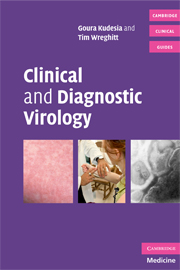Book contents
- Frontmatter
- Contents
- List of plates
- Preface
- Acknowledgements
- SECTION 1 INDIVIDUAL VIRUSES
- SECTION 2 OTHER RELATED AGENTS
- SECTION 3 CLINICAL SYNDROMES
- 32 Central nervous system viral infections
- 33 Viral eye infections
- 34 The common cold
- 35 Respiratory virus infections
- 36 Atypical pneumonia
- 37 Gastroenteritis viruses
- 38 Viral hepatitis
- Chapter 39 Genital tract and sexually transmitted infections (STIs)
- 40 Glandular fever-type illness
- 41 Viral rashes and skin infections
- 42 Infections in pregnancy, congenital and neonatal infections
- 43 Virus infections in immunocompromised patients
- 44 Viral malignancies
- 45 Travel-related infections
- SECTION 4 DIAGNOSTIC TECHNIQUES
- SECTION 5 PATIENT MANAGEMENT
- Index
- Plate section
35 - Respiratory virus infections
Published online by Cambridge University Press: 07 December 2009
- Frontmatter
- Contents
- List of plates
- Preface
- Acknowledgements
- SECTION 1 INDIVIDUAL VIRUSES
- SECTION 2 OTHER RELATED AGENTS
- SECTION 3 CLINICAL SYNDROMES
- 32 Central nervous system viral infections
- 33 Viral eye infections
- 34 The common cold
- 35 Respiratory virus infections
- 36 Atypical pneumonia
- 37 Gastroenteritis viruses
- 38 Viral hepatitis
- Chapter 39 Genital tract and sexually transmitted infections (STIs)
- 40 Glandular fever-type illness
- 41 Viral rashes and skin infections
- 42 Infections in pregnancy, congenital and neonatal infections
- 43 Virus infections in immunocompromised patients
- 44 Viral malignancies
- 45 Travel-related infections
- SECTION 4 DIAGNOSTIC TECHNIQUES
- SECTION 5 PATIENT MANAGEMENT
- Index
- Plate section
Summary
Clinical
Individual respiratory virus infections are difficult to diagnose clinically because they all cause similar symptoms. They often occur in outbreaks, at certain times of the year and in certain age groups, which increases the accuracy of clinical diagnosis. For example, respiratory syncytial virus (RSV) infection most frequently occurs in children under the age of 18 months from November to February each year and is associated with bronchiolitis, sometimes requiring hospital admission.
Several viruses, such as rhinoviruses, coronaviruses, enteroviruses, respiratory adenoviruses and parainfluenza viruses are causes of the ‘common cold’ (see Chapter 34). It is interesting that types 1 and 2 parainfluenza viruses cause outbreaks in the winter while parainfluenza 3 viruses cause summer colds.
Some of these viruses (especially parainfluenza viruses and RSV) can cause pneumonia.
Influenza
Influenza viruses are the most feared cause of respiratory viral infection. As a result of the profound malaise and myalgia associated with influenza, clinical diagnosis is more accurate than with the other viral respiratory infections. Influenza occurs each year in the UK from October to April. Nobody can predict exactly when an outbreak of influenza will occur each year, which virus will be involved, how severe it will be and which age group will be worst affected. If patients acquire a bacterial lung infection on top of influenza, this can result in severe or fatal infection. There is an extensive surveillance programme in the UK for influenza, which involves general practitioners, the Health Protection Agency (HPA) and the Department of Health. This gives impending warning of the first influenza cases of the season, and monitors each evolving national outbreak.
- Type
- Chapter
- Information
- Clinical and Diagnostic Virology , pp. 144 - 146Publisher: Cambridge University PressPrint publication year: 2009



